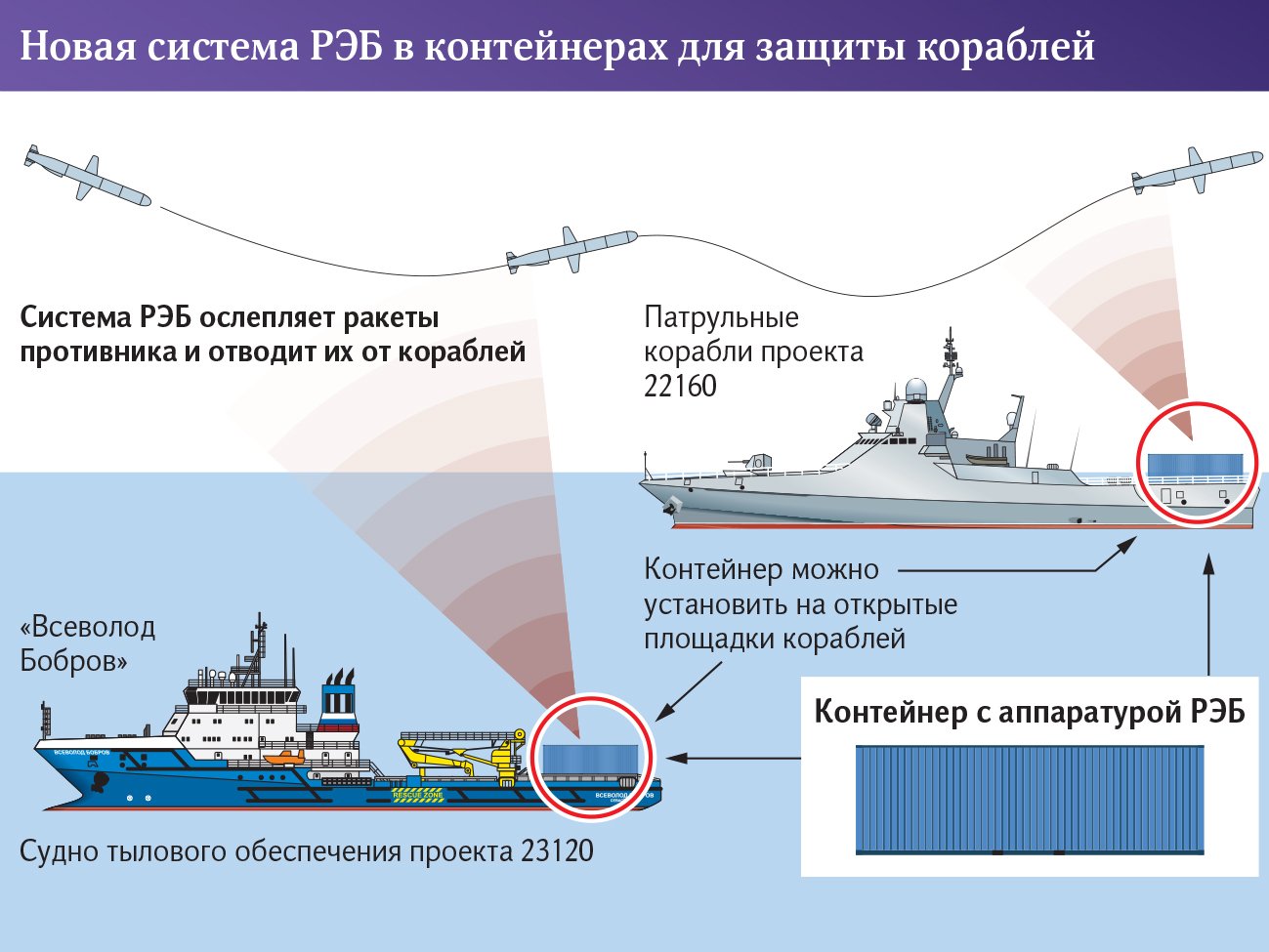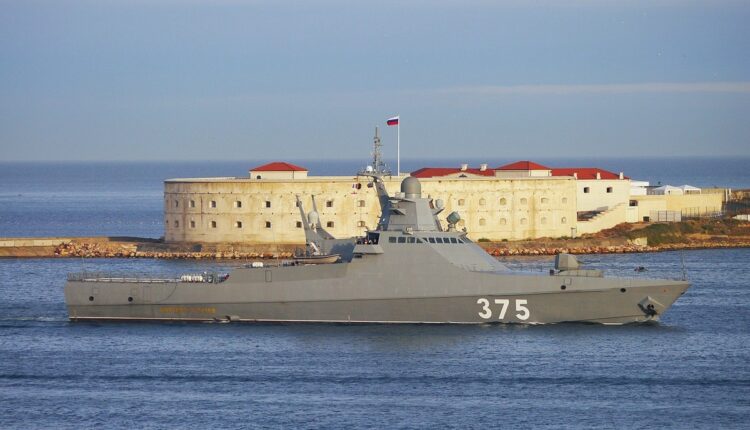©2021 Reporters Post24. All Rights Reserved.
As per the sources within the Russian military, cited by Izvestia, the new Electronic Warfare systems will be installed in standard 40-foot sea containers and can be easily mounted on the deck of various surface ships of the Russian Navy, including auxiliary vessels like tugboats, transports, and others.
According to Izvestia, these protective containers should reliably cover ships and vessels from enemy missiles and drones by jamming their electronics.
The Russian military sources told Izvestia that the Project 22160 series patrol ships would be the first set of platforms within the Russian Navy to receive the new electronic warfare system. The Project 22160 ships are large ships designed for patrol, monitoring, and protection in open and closed seas.
Project 22160 ships will be used to defend the coast and coastal bases in a conflict. They can also be used to escort ship groups and individual ships and in search and rescue and anti-piracy operations.
More importantly, the Project 22160 ships have a modular architecture, which means they can accommodate a variety of weapon systems and equipment for various purposes.
Former chief of the Main Staff of the Russian Navy, Admiral Valentin Selivanov, told Izvestia that the presence of powerful means of electronic warfare is significant for the modern naval fleet.

“Now electronic warfare is used against drones, tactical aircraft, and cruise missiles,” he said.
“And patrol ships, as the name implies, patrol in the coastal zone and will protect the coast precisely from air strikes. Attacks from the sea can be resisted – ships are tracked. But air strikes can be sudden. But if there are powerful means of electronic warfare, then they will be able to fight with drones, aircraft, and missiles,” said Selivanov.
“The means of electronic warfare force the drone to drop its ammunition or land where it is necessary, that is, to disrupt its attack,” Selivanov explained.
The retired Russian admiral recalled that the Russian armed forces already have experience in using electronic warfare equipment in combat conditions in Ukraine.
How EW Is Shaping Ongoing Conflict
As EurAsian Times reported in April, the media coverage of the ongoing Russia-Ukraine conflict primarily focuses on using missiles, artillery, and aircraft. An invisible struggle between the two sides within the electromagnetic domain has been shaping the war significantly.
Russian EW systems fielded in Ukraine include the RB-341В “Leer-3” supported by Orlan-10 drones, the most advanced RB-301B “Borisoglebsk-2” electronic suppression system, and the RB-636 “Svet-KU” and the RB-109A “Bylina” and Tirada-2.
The RB-341В “Leer-3” in conjunction with the Orlan-10 drones are aimed at intercepting satellite navigation signals, 3G, 4G communications, and text messages, while the RB-301B “Borisoglebsk-2” is for blocking Ukrainian military ground and airborne High Frequency (HF) and Ultra High Frequency (UHF) radio channels, and the RB-636 “Svet-KU,” whose role is to locate and intercept radio signals.
The RB-109A “Bylina” and Tirada-2 are used to degrade and jam communications satellite transmissions.
The R-934B “Sinitsa” jamming station can also disrupt and, if necessary, even damage satellites’ communications and guidance systems in low-Earth orbit (LEO).
In addition to that, there are the 1RL257 “Krasukha-C4” and the R-330Zh “Zhitel” automatic jamming stations for reconnaissance and electronic attack (EA) aimed at jamming the long distances radar signals of the US Air Force’s AWACS E-3 Sentry and AEW E-2 Hawkeye airborne warning and control aircraft, trying to locate Russian fighters in flight.

In the initial months of the war, this extensive array of Russian EW systems appeared to be failing, puzzling many military experts who have been tracking Russian EW capabilities and concepts for years.
However, ever since the conflict has shifted to the east and south of Ukraine, close to the Russian territory and the Russian-held Crimean peninsula, the performance of the Russian EW units appears to have improved significantly, especially against the Ukrainian unmanned aerial vehicles (UAVs).
Ukrainian Drones Getting Jammed?
It is important to note that drones were instrumental in the Ukrainian battlefield successes in the initial months of the war when the Russian military was advancing toward Kyiv to seize the Ukrainian capital.
Social media at the time was abuzz with videos showing Russian tanks, air defense systems, helicopters, and supply trucks being knocked out by drone or drone-assisted artillery strikes.
However, this began to change after Russia made Donbas the sole focus of its military campaign in Ukraine.
Reports began emerging that the Russian military is increasingly employing its EW systems because of shorter, easier-to-defend supply lines. It allowed the Russian electronic warfare gear to be fielded closer to the frontlines. Whereas, in the initial phase of the war, Russian military convoys were getting stalled due to lack of fuel and other logistical issues.
Also, according to Dr. Thomas Withington, an expert on electronic warfare, radar, and military communications, east Ukraine is very different from Kyiv, where the Russian military is mainly fighting in an open country which eases electronic attacks against UAVs, as it minimizes risks of jamming signals getting blocked out by large buildings.
In June, a Ukrainian Intelligence official revealed that the Russian jamming of GPS receivers on drones that Ukraine uses to locate the enemy and direct artillery fire is particularly intense “on the line of contact.”
Similar reports have been coming in even from the southern Ukrainian region where the Ukrainian military is conducting its Kherson offensive.
Wounded Ukrainian soldiers who were a part of the ongoing Kherson offensive have revealed that their drones are being hijacked by Russian hacking tools, leaving Ukrainian operators helpless.
That said, it is also important to remember that it is impossible to get a definitive picture of the use and effectiveness of the Russian EW capabilities amidst the fog of ongoing war, as Electromagnetic Spectrum is an invisible domain and the available information is fragmentary.


